Wordless Wednesday: A Glass of Hidden Mickey
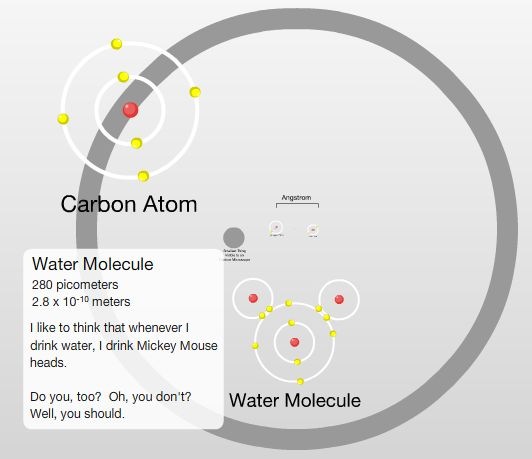
This screen shot is from The Scale of the Universe 2, a wonderful animation that everyone should spend awhile browsing through.

This screen shot is from The Scale of the Universe 2, a wonderful animation that everyone should spend awhile browsing through.

This past weekend, there was a parent-student program at NHL’s Hebrew school. We first spoke about the challenges and best techniques to teach our kids to be thankful. Most kids today are lucky enough that their main problems involve what toys they get for birthdays/holidays or whether or not they have the latest versions of the most popular electronic gadgets. Travel to a different country, however, and a kid might be worrying more about whether his latest meal will be today or tomorrow or whether his parents will be able to pay the doctors to treat his sick baby brother. Compared to those concerns, getting the latest iPhone seems pretty petty.
Sadly, the culture we live in is defined by consume-consume-consume. I wish I could say my boys are immune to it, but they aren’t. They have plenty of toys (some days it seems like too many toys – especially when they don’t clean up) and yet they constantly want more. We can’t exit any store without JSL asking for a new toy for him to open right now. The fact we never give in to these new toy cries doesn’t seem to deter JSL.
One parent mentioned having toys “disappear” only to reappear months later. We’ve used this cycle in and out strategy before. Perhaps we should employ it a bit more.
Later on, NHL and his class came into the room. We got to decorate a sheet and write in what NHL was thankful for. This is what NHL wrote down for what he was thankful for.
Did you catch that one right before the end? “Supermassive Black Holes.” In case you’re wondering, NHL got that from this page
Of this book:
This book lists scientifically accurate information about the objects in our universe. From the planets to black holes, from the Hubble Space telescope to space-time. Of course, the facts are simplified for kids and the illustrations are made to be fun to look at. Still, NHL has taken to this book and the page on supermassive black holes in particular.
It’s quite fun to watch him weave science and math into what seems to be otherwise unrelated projects. He’s really got the mind of a junior scientist and I’m going to love teaching him more and more about the world (and universe) around us.
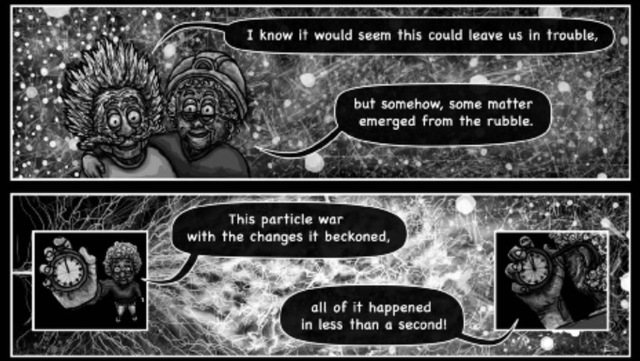
I love science. NHL does too. So when I heard about James Lu Dunbar and his The Universe Verse series, I just had to check out his work. I’ve heard it compared to a mixture of Carl Sagan and Dr. Seuss. This is a very apt comparison.
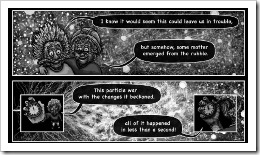 I read the first of the series, Bang!, to NHL and JSL. The book starts out before the Big Bang. They describe the tiny speck that the Universe began as and then the tremendous explosion of the Big Bang. The book covers energy cooling into matter, the formation of the basic forces (such as gravity) that dictate how matter behaves. It goes on to describe the first atoms, how they gathered together into stars and finally how some of those stars became supernovas.
I read the first of the series, Bang!, to NHL and JSL. The book starts out before the Big Bang. They describe the tiny speck that the Universe began as and then the tremendous explosion of the Big Bang. The book covers energy cooling into matter, the formation of the basic forces (such as gravity) that dictate how matter behaves. It goes on to describe the first atoms, how they gathered together into stars and finally how some of those stars became supernovas.
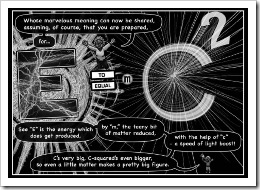 All along the way, the narration rhymes in a manner that would make the Cat in the Hat proud minus made up words. All of the weird looking words here are actually scientific terms and are used validly. This is a book that could be used by high school physics students. It really takes difficult to understand terms and simplifies them without losing any of the wonder of it all.
All along the way, the narration rhymes in a manner that would make the Cat in the Hat proud minus made up words. All of the weird looking words here are actually scientific terms and are used validly. This is a book that could be used by high school physics students. It really takes difficult to understand terms and simplifies them without losing any of the wonder of it all.
Of course, considering the weighty subject matter, reading this to a 4 year old and an 8 year old was a risky proposition. JSL was a bit bored by it, but I didn’t really think he’d enjoy it. Honestly, the only reason he listened in was because NHL and I were reading it and he didn’t want to be left out.
NHL, my science geek-in-training, loved it. He definitely didn’t understood all of the physics that was described, but I really didn’t think he would. What he did understand, though, was that this was an extremely entertaining story of how the Universe was formed.
The second book in the series is called “It’s Alive!” After a quick rehash of how the Universe was formed, condensed to a mere 3 pages, the book discusses planet formation, the beginnings of life, Evolution, biology, DNA, the food chain and more. Unlike the first book, this one is in full color. (Bang! was in black and white.)
I initially planned on reading this to NHL, but changed my mind. My concern wasn’t about him not liking the book, but for brief references to sex. Mind you, these are done within the context of evolution and genes combining. There is absolutely titillating about the presentation. Still, the word was there and I didn’t want my 8 year old asking questions I wasn’t ready to answer just yet. Here’s the panel in question. I’ll leave it up to you whether or not you’d show this to a third grader.
There’s still one book that hasn’t been released yet. After reading the first two, I eagerly await James’ final book of the trilogy. Reading his blog, it appears that this will cover (in part), agriculture and civilization forming. If the quality of the third book is as good as the first two, this will be one set that every classroom should have.
The two currently released books in the Universe Verse series can be purchased for $12.95 for the first book and $15.95 for the second. You can also e-mail him and he’ll send you the PDFs for free. These will definitely be eBooks that I’ll keep and go over with NHL and JSL as they get older. I’ll even re-read them myself just for the pure fun of it.
Disclaimer: I received the first two books for free as PDFs, however, as mentioned above, anyone can do this. No review was required and all opinions expressed above are my own.

 Recently, NHL decided to drop a random scientific fact that he picked up along the way. He told us that butterflies can see colors that we can’t see. It’s true also. Many butterflies can see into the ultraviolet range of colors.
Recently, NHL decided to drop a random scientific fact that he picked up along the way. He told us that butterflies can see colors that we can’t see. It’s true also. Many butterflies can see into the ultraviolet range of colors.
I tried to explain to NHL about the electromagnetic spectrum. I explained how light makes waves and how “big” or ”small” the waves are determines what the color of the light is. Bigger waves can be seen as red light while smaller waves will be seen as violet/purple. Between those are the orange, yellow, green, blue, and indigo that anyone familiar with ROYGBIV should remember.
Of course, the idea that light is a wave is a very complex and abstract notion to an 8 year old. I don’t think he quite got it. He did seem impressed when I linked it back to something that directly affects him, however. I let him know that just outside of the light that we could see was ultraviolet light. (At the time, I didn’t know that this was the “color” butterflies could see. I found that out later via a Google search.) I explained to him that ultraviolet light was the kind of light that caused us to get suntans and sunburns. Thus, we needed suntan lotion to protect us against this kind of light.
This resulted in a wide-eyes “aha” moment in NHL’s brain. I love seeing those moments in action. Hopefully, this year, I’ll see a lot more of them.
What science facts do you enjoy sharing with your kids?
Don’t forget to enter my Hot Wheels Nitro Speeders giveaway!
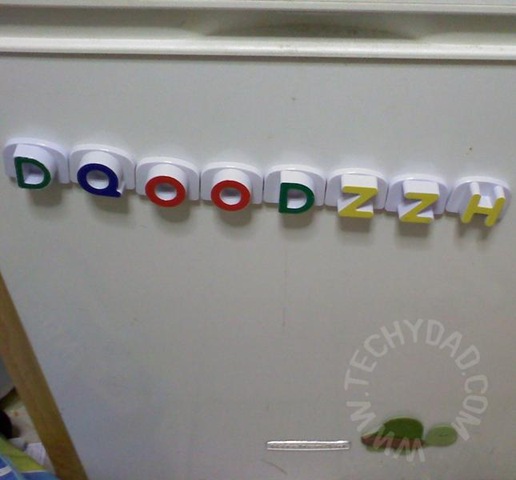
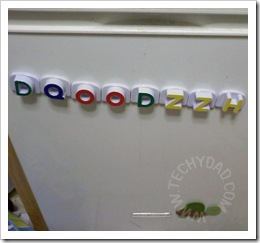 This morning, as I was preparing lunches and snacks for NHL and myself, JSL came into the kitchen to play. As he usually does, he was taking magnets off the fridge and repositioning them. Then he took a turtle magnet off and looked at it. Glancing to his side, he spied the dishwasher. The turtle magnet got put on the door to the dishwasher and JSL was amazed. It stuck in place!
This morning, as I was preparing lunches and snacks for NHL and myself, JSL came into the kitchen to play. As he usually does, he was taking magnets off the fridge and repositioning them. Then he took a turtle magnet off and looked at it. Glancing to his side, he spied the dishwasher. The turtle magnet got put on the door to the dishwasher and JSL was amazed. It stuck in place!
He quickly brought this fascinating fact to my attention. “Daddy! Daddy! It sticking! See?!”
After entertaining himself with his new magnet-location, JSL did something that impressed me. He took the magnet off the turtle and tried sticking it to the cabinet. Why did this impress me? Simple. He was experimenting. He had found a new and interesting phenomenon and was testing the limits of this. Magnets stick to fridges (known) and dishwasher doors (new). Do they stick to cabinets? No. What about walls? Also, no.
He asked me about the sticking so I took the time (which still packing lunches) to explain to him that magnets stick to metal which the fridge and dishwasher have in them. He asked what else was metal and I mentioned that the oven might be, but he would need to try it out. He excitedly put the magnet to the oven door and… it fell off. So much for that theory.
Still, his excitement at testing a new theory fills my geeky heart with joy. I know that NHL has an inner geek (he loves Star Wars, is enthralled by super hero cartoons, loves playing on the computer, etc), but I wasn’t completely sure about JSL. I’d say this is some good proof that JSL has a bright future on the Geek Side!
P.S. Sorry for the cell phone photo above. As I mentioned earlier, I was rushing to make lunches/snacks and get NHL to school. I didn’t have time to get my camera out for a proper photo.